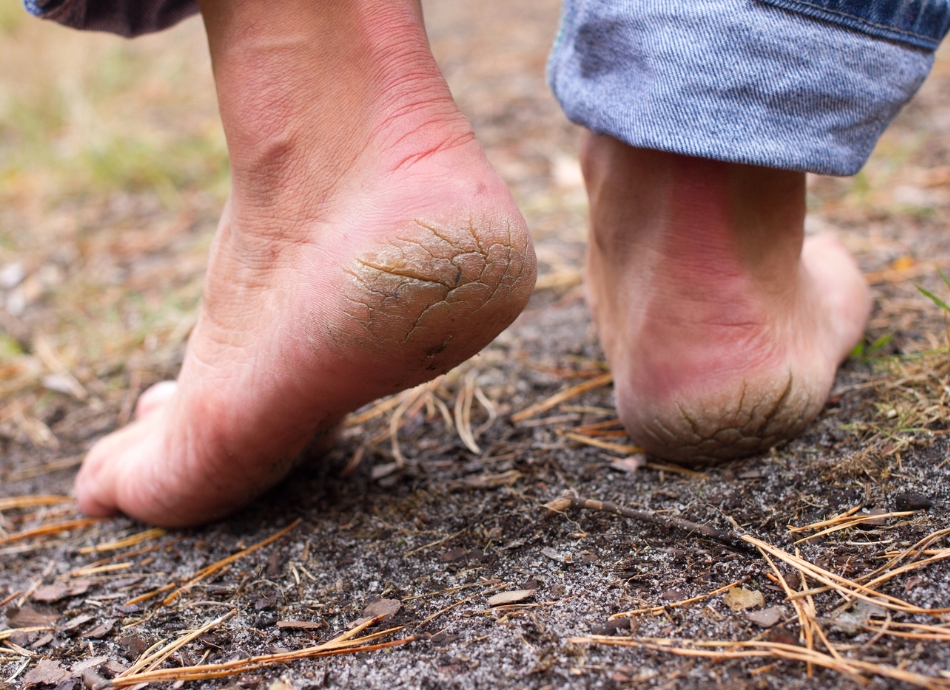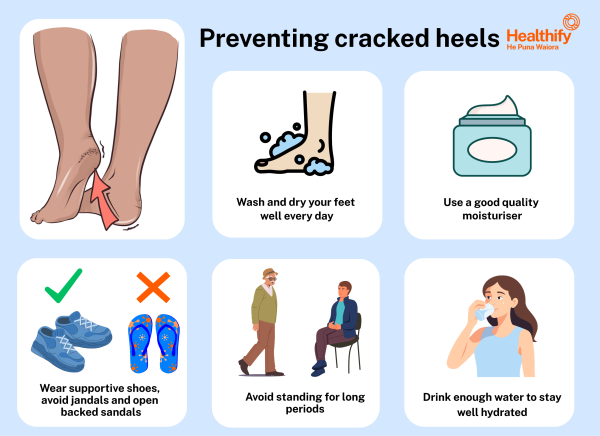Cracked heels and how to heal them
Also known as fissured or split heel
Key points about cracked heels
- Cracked heels occur when there’s dry, hard, thickened skin around the edge of your heel.
- They’re of particular concern if you have diabetes, as the cracks may lead to diabetic foot ulcers.
- In severe cases, cracked heels can become infected and lead to cellulitis. This needs urgent medical attention.
- To help prevent cracked heels, rub them with a moisturising cream regularly to keep the skin soft and hydrated.
- See your healthcare provider if you have severely cracked heels or if they’re not healing after a week of self-treatment.

Cracked heels are a common foot problem that usually occurs because you have dry skin on your feet. The lack of moisture makes your skin less elastic and more likely to crack. When you put weight on the fat pad in your heel, it expands sideways and causes cracks or fissures in your skin. They can be very painful and if they’re not treated the cracks can become infected.
Anyone can get cracked heels, but you may be more likely to get them if you have:
- dry skin
- atopic dermatitis
- psoriasis – especially on the sole of your foot
- thickened skin on the soles of your feet
- certain conditions, such as diabetes and hypothyroidism.
Some factors that contribute to cracking or splitting of your heels include:
- being overweight
- standing for long periods of time, especially on hard floors
- open-back shoes and sandals, as they don't provide support to hold the fat pad under your foot
- playing a sport where you stand for long periods, such as lawn bowls.
Cracked heels and diabetes
Cracked heels are of particular concern if you have diabetes, as the cracks may lead to diabetic foot ulcers. Foot problems can be avoided if you take care of your feet, check them daily and act quickly if you find a problem. Find out how to take care of your feet if you have diabetes.
The first sign of getting a cracked heel is the development of dry, hard, thickened skin around the edge of your heel. This is called a callus. It may be a yellow or dark brown colour.
At first, small cracks over the callus are visible. If left untreated, and as you put more pressure on your heel, these cracks become deeper. Eventually, walking and standing becomes painful. The cracks can get so deep that they begin to bleed.
In severe cases, cracked heels can become infected and lead to cellulitis. This is an infection in the deeper layers of your skin and needs urgent medical attention.
If you have cracked heels, you should soak and moisturise your feet at least twice a day. Use thick creams that have skin softeners in them.
- Start by soaking your feet in warm water for 20 minutes.
- Then gently scrub your heels with a loofah or pumice stone to remove the thick, hard skin.
- Dry your feet thoroughly.
- Apply a thick moisturiser, such as petroleum jelly, to your dry feet, and then put on a pair of thick socks to keep the moisturiser in place.
If you’re buying over-the-counter products for treating or preventing dry feet and heels, look for ones that contain urea, salicylic acid (eg, HealthE cream), alpha-hydroxy acid (eg, QV Heel Balm), saccharide isomerate (eg, Ellgy Heel Balm), or petroleum jelly (eg, Vaseline). These ingredients help moisturise and soften skin and some help remove dead skin and decrease skin thickness. Note that some of these products might cause stinging or irritation when applied to cracks or other broken skin.
See your healthcare provider or a podiatrist if there’s no improvement after a week of self-treatment.
You can usually treat cracked heels at home with self-care. However, if your heels are severely cracked or don't improve after you've treated them for a week, you may need treatment from a podiatrist or a specialist foot doctor.
You should also see a healthcare provider if you notice redness or other signs of infection, such as an odour or leaking cracks.
Possible treatment options
- Strapping your heel with a bandage or dressings to keep the skin from moving around.
- Cutting away the thick skin on your heels. This is called debridement. Don't try to do this yourself as you may cut away too much skin, causing an infection.
- Using a cream prescribed by your healthcare provider that’s stronger than creams you can buy over the counter.
- Having the heel cracks glued with a special skin glue to hold the edges together so they can heal.
- Wearing shoe inserts that provide support by redistributing the weight on your heel. This can prevent the fat pad from expanding sideways and cracking your heels.
To prevent cracked heels you should check your feet every day so you’ll spot problems before they become serious. This is especially important if you have diabetes. Look for things such as swelling, cuts, athlete’s foot or red or warm spots.
Rub your heels with a moisturising cream on a regular basis to keep your skin soft and hydrated.
At the first sign of any cracking, applying moisturiser 2 to 3 times a day may be all that’s needed for the cracked skin to heal. You can gently rub a pumice stone against the callus to take away some of the thick hard skin before applying moisturiser.
Other things to do to help prevent cracked heels
- Wash your feet every day using warm water. Dry them well, especially between your toes.
- Wear supportive footwear and avoid bare feet, jandals and open backed sandals.
- Wear clean, lightly padded, well-fitting socks.
- Protect your feet. Wear shoes at the beach and on hot footpaths. Wear socks to bed if your feet get cold at night.
- Avoid standing for long periods if possible.
- Drink plenty of water to stay hydrated.

Image credit: Healthify He Puna Waiora
References
- Cracked heels – stop them in their tracks(external link) BPAC, NZ, 2014
- Cracked heel(external link) DermNet, NZ
- What to know about cracked heels(external link) WebMD, US, 2025
- Cracked heels(external link) The Feet People, Australia
Credits: Healthify editorial team. Healthify is brought to you by Health Navigator Charitable Trust.
Reviewed by: Dr Sara Jayne Pietersen, FRNZCGP, Auckland
Last reviewed:





